
About UsThe Numismatic Bibliomania Society is a non-profit organization promoting numismatic literature. For more information please see our web site at coinbooks.org SubscriptionsThose wishing to become new E-Sylum subscribers (or wishing to Unsubscribe) can go to the following web page link MembershipThere is a membership application available on the web site Membership Application To join, print the application and return it with your check to the address printed on the application. Membership is only $15 to addresses in the U.S., $20 for First Class mail, and $25 elsewhere. For those without web access, write to: David M. Sundman, Secretary/TreasurerNumismatic Bibliomania
Society AsylumFor Asylum mailing address changes and other membership questions, contact David at this email address: dsundman@LittletonCoin.com SubmissionsTo submit items for publication in The E-Sylum, just Reply to this message, or write to the Editor at this address: whomren@coinlibrary.com
BUY THE BOOK BEFORE THE COINYou won't regret it! |
- WAYNE'S WORDS: THE E-SYLUM SEPTEMBER 19, 2010
- NBS U.S. NUMISMATIC BIBLIOGRAPHY PROJECT UPDATE
- KOLBE & FANNING SALE #117 AND #118 RESULTS
- DAVIS SALE OF DAVISSON AND HODDER MATERIAL CLOSES OCTOBER 30, 2010
- BOOK REVIEW: THE PAPER REPUBLIC BY JAMES P. BEVILL
- BOOK REVIEW: DOTAN, WATERCRAFT ON WORLD COINS VOLUME II
- GUTTAG'S COINS OF NEW JERSEY
- THE HISTORY OF LETTERING ON U.S. COINAGE
- DAVE BOWERS ON WOODGRAIN COIN SURFACES
- A FRENCH COUNTERMARK OF LOUIS XIII FOUND IN SRI LANKA
- BALDWIN'S OFFERS MICHAEL HALL COLLECTION OF RENAISSANCE AND LATER MEDALS, PART III
- HARVEY STACK ON SUPPORTING YOUNG NUMISMATIST PROGRAMS
- WHY THE U.S. CENT MAY NEVER DIE
- MORE ON THE WORST NUMISMATIC BOOKS
- A LIBRARY DESK MADE OF BOOKS
- LOST LIBRARIES: THE STRANGE AFTERLIFE OF AUTHORS’ BOOK COLLECTIONS
- ON UNIVERSITY DEGREES IN NUMISMATICS
- COIN FOUND IN GERMANY IS SASSANIAN, NOT ARABIC
- ARTIST USES FOUND CENTS FOR INSPIRATION
- ANDY WARHOL’S INDIAN HEAD NICKEL DISPLAYED AT WASHINGTON HOTEL
- WAYNE'S NUMISMATIC DIARY: SEPTEMBER 19, 2010
- BONHAMS'S TO SELL MEDAL AWARDED TO CARPATHIA CREW FOR TITANIC RESCUE
- DANIEL CHESTER FRENCH 1893 COLUMBIAN EXPO BULL STATUE RECOVERED
- MAST COIN FOUND IN SHIP EXCAVATED AT WORLD TRADE CENTER SITE
- FANCIERS TO HONOR DICKIN MEDAL WINNING PADDY THE PIGEON
- BANK ROBBER FILLS OUT PAPERWORK FOR A LOAN
- FEATURED WEB PAGE: ABNER KREISBERG'S 50% OFF SALE
WAYNE'S WORDS: THE E-SYLUM SEPTEMBER 19, 2010

Among our new subscribers this week are Andy Singer, courtesy of Dave Schenkman, and Roman Kitaev. Welcome aboard! We now have 1,372 subscribers.
This week we open with an update on the NBS Wiki Bibliography, results of this weeks' Kolbe & Fanning sales, and word from Charlie Davis on his upcoming sale of numismatic literature from the libraries of Allan Davisson and Michael Hodder. Next is a new review of James Bevill's recent book on Texas paper money. Other topics include Guttag's Coins of New Jersey book, lettering on U.S. coins, and why the U.S. cent still clings to life.
Regarding last week's issue, Joe Boling writes: "I laughed aloud at your line about monkeys and typewriters." Well, we've got some more humor this week in submissions from Tom DeLorey and Harvey Stack.
To learn about a French countermark of Louis XIII found in Sri Lanka, more about the "Arabic" coin found in Germany, the meaning of "opistrographic", Andy Warhol's Indian Head Nickel, ships on coins, coins on ships, and a medal for a sunken ship, read on. Have a great week, everyone!
Wayne Homren
Numismatic Bibliomania Society
NBS U.S. NUMISMATIC BIBLIOGRAPHY PROJECT UPDATE
I completed #4 - A Guide Book Of United States Coins. Geez, I had no idea there were so many versions of those made...


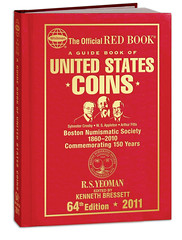
I also need to recruit some help for the following entries:
- American Numismatic Association, THE NUMISMATIST.
- Amos Press. COIN WORLD.
- Numismatic Bibliomania Society. THE ASYLUM.
- Early American Coppers Club. PENNY WISE.
- Colonial Newsletter Foundation. THE COLONIAL NEWSLETTER.
- HARPER, David C., Editor. NUMISMATIC NEWS.
Sure am glad I saved the easy ones for last. LOL..
So - who can give Tom a hand on some of these titles? We don't need a dissertation or even a full-blown article, just some basic facts, dates, descriptions, and/or cover images of sample issues. Please lend a hand in creating what could become the best online resource for U.S. bibliophiles. Comments and criticism welcome! Thanks also to all those who have already helped out, including Charlie Davis, George Kolbe and Whitman Publishing, who all provided images for the Guide Book page. -Editor
To read the Guide Book page, see: A Guide Book Of United States Coins (wiki.coinbooks.org/index.php/A_Guide_Book_Of_United_States_Coins)
To view the complete survey results, see:
The One Hundred Greatest Items Of United States Numismatic Literature: A Survey of the Numismatic Bibliomania Society
(wiki.coinbooks.org/index.php/The_One_Hundred_Greatest
_Items_Of_United_States_Numismatic_Literature)
KOLBE & FANNING SALE #117 AND #118 RESULTS

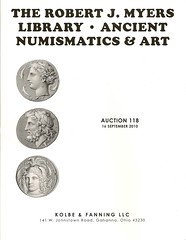
Kolbe & Fanning Numismatic Booksellers recently conducted the auction sales of the Anders Frösell library of early printed numismatic books and the Robert J. Myers library of literature pertaining to ancient numismatics and art.
On Sunday, 12 September, Kolbe & Fanning offered a small group of antiquarian volumes from the library of Swedish numismatist Anders Frösell. The 48 lots composing the sale did well, with hammer prices approaching 130% of the estimated total value. The highlight of the sale was Valentin Duval’s magnificent 1756 catalogue of the European silver pieces in Empress Maria Theresa’s coin cabinet. The large folio volume, featuring exceptional engravings of some 2500 pieces, brought spirited bidding in Europe and the United States before closing at $11,000 hammer. Other highlights included the Fasti et triumphi Romanorum of Onuphrius Panvinius (1557), which brought $2200, and a copy of the 1554 edition of Aenea Vico’s Omnium Caesarum, which sold for $2100.
The Robert J. Myers library, sold on Thursday, 16 September, was remarkable both for its depth and scope, comprising over 1300 lots of works on ancient numismatics, archaeology, history and art. Highlights of the sale included volumes of Ernest Babelon’s Traité des monnaies grecques et romaines, including all plate volumes, which sold for $3500, and a complete set of A Catalogue of the Greek Coins in the British Museum, which brought $2850. Robinson and Clement’s rare and important work on the Chalcidic mint brought $2750, as did a set of Collection R. Jameson. Imhoof-Blumer’s Die antiken Münzen Nord-Griechenlands brought a strong $2400 on a $1250 estimate, with several bidders competing.
Kolbe & Fanning will be holding a mail-bid sale closing 18 November, offering a variety of works on U.S., ancient and foreign numismatics, and will be holding a public auction on 8 January 2011 at the Waldorf-Astoria in New York, as part of the New York International Numismatic Convention. Selected consignments of rare numismatic literature are still being sought for the latter sale.
For more information, please see Kolbe & Fanning’s website at www.numislit.com .
DAVIS SALE OF DAVISSON AND HODDER MATERIAL CLOSES OCTOBER 30, 2010
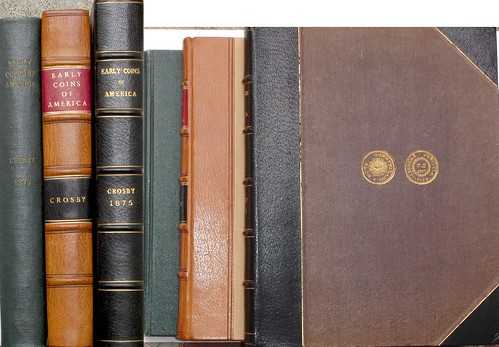
Our next mail bid sale of numismatic literature closes October 30 and will feature selections from the British token library of Allan Davisson, additional colonial research material from Michael Hodder, and selections from the library of A. Piatt Andrew, diplomat and once Director of the Mint
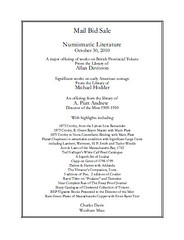
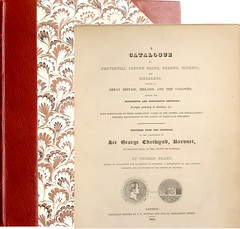
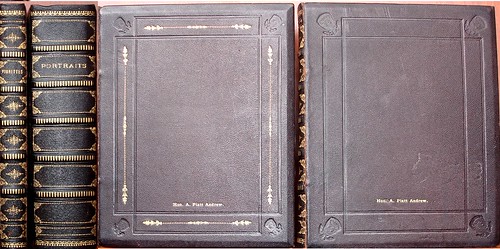
Perhaps the most unusual item is a set of BEP Portraits and Vignettes bound in 2 cases rather than the usual one and presented to Andrew c1910, an offering of three original Crosby Early Coins of America - one bound in the Nova Constellation cloth, and a second being the R. Green "repro-master" used to make the 1945 reprint, both with the Woodburytype plate.
A group of 8 plated Chapmans include a near mint H.P. Smith, an absolutely mint Wilson, and a rare Taylor-Windle. The Davisson library contains all three editions of Pye, two of Condor, and the rare Sharp Chetwynd. Also included are a 1913 interleaved Adams & Woodin, near complete Essay Proof Journal lacking but a single issue, and a set of the rare Greco plates of Massachusetts copper with even rarer text.
The catalogue will be posted at www.vcoins.com/ancient/charlesdavis and will be available at the Philadelphia Whitman show which starts September 30. As with our last sale, we plan to have several hundred of the lots illustrated on the web site as well.
BOOK REVIEW: THE PAPER REPUBLIC BY JAMES P. BEVILL
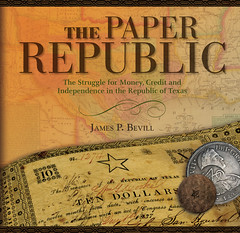 The Paper Republic by James P. Bevill (Bright Sky Press, 2009) 352 pp., hardcover, (illustrated), $60.00.
The Paper Republic by James P. Bevill (Bright Sky Press, 2009) 352 pp., hardcover, (illustrated), $60.00.
Students of Texas history might think that there is little new to say on the subject. Historians, however, learned long ago never to say “never” on this subject. James P. Bevill has proven them wise with The Paper Republic, a large, lavishly illustrated volume that takes yet another look at his state’s history, from the coming of the Spaniards to its annexation by the United States and the ensuing war with Mexico.
All along the way, Bevill “shows us the money”; the coin and paper scrip used by the various masters of Texas, from early Spanish gold doubloons and pieces of eight through dubious promissory notes issued by the hard-pressed, fledgling Texas Republic. By hinging his historical account to these various forms of money Bevill opens a new window into the state’s history, particularly its revolution and relationship with the United States.
Money was always necessary: to pay soldiers, to build missions, to outfit armies, or to fund governments. It took many forms, ranging from hammered silver coins to hand-written notes. History scattered a varied assortment of coins and paper money throughout Texas for nearly a century and a half, and Bevill traces it all as he relates the state’s long, often violent history.
Although the author focuses on money, personalities populate the book throughout; many of them both interesting and obscure while others are familiar faces. For example, we get a crash course in the Bowie brothers’ lucrative slave trading scams that involved the pirate Jean Lafitte. But, we also meet the relatively obscure Branch T. Archer, a Revolutionary War veteran from Virginia who had once shot his own cousin in a duel and later chaired the first Texas Consultation during the revolution.
This is a beautiful, informative volume, filled with images of coins, paper money, historical documents, photographs and paintings from various periods of the state’s history, some of them rarely seen. It is both a valuable overview of Texas history and a guide to the money produced by its many rulers, bearing images as diverse as Spanish monarchs and Texian scouts. With these images, they left their mark and marked their time on the land.
The Paper Republic is the best new work on Texas history in some time; there is much to learn from it and much to enjoy.
Allen J. Wiener
BOOK REVIEW: DOTAN, WATERCRAFT ON WORLD COINS VOLUME II
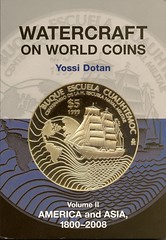 Author Yossi Dotan kindly sent me a copy of the latest volume in his series on watercraft on world coins. Watercraft on World Coins Volume II: America and Asia 1800-2008 was published this year by The Alpha Press. Volume I came out in 2007, covering Europe. Volume III will cover Africa and Oceana 1800-2011.
Author Yossi Dotan kindly sent me a copy of the latest volume in his series on watercraft on world coins. Watercraft on World Coins Volume II: America and Asia 1800-2008 was published this year by The Alpha Press. Volume I came out in 2007, covering Europe. Volume III will cover Africa and Oceana 1800-2011.
The format is identical to Volume I, which I reviewed in November 2007. Much of what I said then still applies to Volume II:
I have to say this is probably one of the best books I've ever seen on a topical numismatic subject. No mere catalog, the book delves deeply into the background of each coin, providing anywhere from a few sentences to a full page of information about each coin, its history and design, and the history of the watercraft depicted.
Krause-Mishler (KM) numbers are used, providing easy cross-reference to the standard price catalogues. This is ideal, for a topical book has a far longer shelf-life than price catalogs, and had any prices been included they would quickly become outdated.
QUICK QUIZ: which coins in the U.S. Statehood Quarter Dollar series picture watercraft? They are all listed and pictured here. How many other U.S. coins (including commemoratives) picture watercraft? This chapter of the book would make a great guide for building an interesting collection and exhibit of U.S. coins.
There are quite a few coin designs that I really like. Some of the U.S. design are among them, but I also like a 1964 25 fils coins from Yemen, picturing a traditional fishing dhow (p331).
The volume passes my back-of-the-book test: there is a detailed six-page index and an impressive five-page Select Bibliography. Thoughtfully included is a section with additions and errata to Volume I, Europe.
The back cover provides a short bio of Dotan, "a numisnautical researcher, a recognized expert in modern coins which depict watercraft. 'Ship coins' have fascinated him for 30 years. He is a contributor to the Standard Catalog of World Coins."
The 346-page paperback book is illustrated with some 500 coin images and is priced at £49.50 ($79.95). For more information or to order, see: www.sussex-academic.co.uk/sa/titles/alpha_press/dotan.htm .
To read the earlier E-Sylum article, see: REVIEW: WATERCRAFT ON WORLD COINS, VOLUME I BY YOSSI DOTAN (www.coinbooks.org/esylum_v10n45a05.html)
THE BOOK BAZARRE
GUTTAG'S COINS OF NEW JERSEY
Last week Ray Williams wrote:
I have a couple copies of a 1927 Guttag publication that has line drawings of New Jersey Coppers. I've heard that there is a 1925 Guttag work on New Jersey Coppers but can't find any information about it. Does a 1925 Guttag exist with extensive line drawings of New Jersey Coppers?
Tom Wetter writes:
Yes, a 1925 version exists (in both softbound and special hardbound) and does contain 18 leaves with illustrations. George Frederick Kolbe - Ford Library Part 1, Lot 524 has additional information.
Charlie Davis writes:
The New Jersey title queried by Ray Williams is listed as #462 in my book American Numismatic Literature, and the front cover of the very rare hardbound edition was illustrated in the Champa sale - lot 1260."
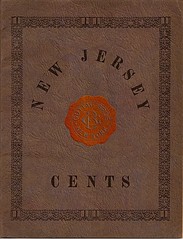
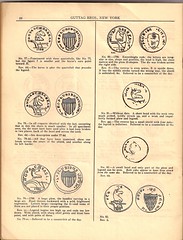
Images courtesy John Lupia
John Lupia writes:
Ray Williams and Roger Siboni visited my house in 2006 and I showed them my copy of the 1925 Guttag edition and commended the line drawings. I guess he/they forgot. At the time Ray was more interested in the photographic plate to Maris over that of the line drawings published by Guttag; and he and Roger published an article about it.
I have not seen the 1927 issue and do not know if it is a reprint or an edition. The issue of 1925 has a light/medium brown and gray patina leatherette grained card stock cover with an early Art Deco floral and open book border in black ink.
Centered on the cover is the Guttag Bros. logo embossed in cadmium orange with the raised letters in the light/medium brown of the faux leather. The printing is interleaved very similar to the Cogan, June 29, 1865 coin auction catalog, with the text printed on the versos with the rectos blank. Only the fourth leaf is opistrographic, i.e., printed on both sides. Pagination skips blank leaves and is inclusive of all printed sides totaling 20 printed pages.
Julius Guttag added four new varieties to Dr. Edward Maris' list, keeping the Maris numbering system. These additions are on the last page, i.e. 20; Nos. 80ff, 81gg, 82hh, 83ii. There is a copy of New Jersey Cents published in 1925 by the Guttag Brothers in Rutgers Alexander Library in New Brunswick.
THE HISTORY OF LETTERING ON U.S. COINAGE
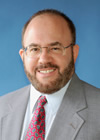 By the time the US Mint began its operations in 1792, there were artisans who specialized in the creation of letter and numeral punches for the printing and engraving trades, among other skills. A good example may be found in the set of punches future mint engraver Christian Gobrecht created for the US Mint in 1825, while he was still self-employed.
By the time the US Mint began its operations in 1792, there were artisans who specialized in the creation of letter and numeral punches for the printing and engraving trades, among other skills. A good example may be found in the set of punches future mint engraver Christian Gobrecht created for the US Mint in 1825, while he was still self-employed.
The problem with having a complete matching set of such punches is that a few will fail at some point. Replacements for these damaged tools were not always obtained from the same source, and the result was an obvious mismatch in the mottoes and legends on subsequent dies. Collectors of early federal coins can point to numerous examples, such as the 1803 dimes having letter A's that are narrower than both the remaining letters and the A’s in other dime varieties of that date. Numerals, too, suffered from the loss of a single punch, as seen in the half dollars of 1828. Most of the several obverse dies used that year have small 8s that are clearly not from the same set of punches as the larger 1s and 2s.
With the arrival of the Contamin portrait lathe in 1835, the US Mint was able to create master dies that included all characters aside from the date and mintmark, thereby confining such variations in style to those features alone. While the lettering was thereafter consistent from one date to the next, it was still applied to the master die with hand punches and could thus be a bit irregular. The master dies created by James B. Longacre are notorious for their drunken lettering, which was poorly spaced and failed to follow a single arc. This may be seen most clearly in the gold dollars of 1849-89.
Later US Mint chief engravers perfected the placement of lettering. Both Barbers — Charles and William — were skilled in maintaining neatly aligned legends and mottoes. William still punched his characters directly into the die steel at the master die stage, but son Charles worked in clay or plaster to create most of his designs. After sculpting the main devices in relief, he would then make a negative cast into which the lettering was either punched or sculpted. Another casting would result in a completed positive model that could then be reduced mechanically to create a master hub. Charles Barber did vary from this technique in one notable exception—the Lafayette Dollar. For some reason he punched the legends into each of the several working dies used. This resulted in slightly irregular (and sometimes repunched) lettering that makes the various dies distinctive and collectible.
To read the complete article, see: USA Coin Album: Take a Letter (www.ngccoin.com/news/viewarticle.aspx?IDArticle=1751&USA-Coin-Album)
DAVE BOWERS ON WOODGRAIN COIN SURFACES
 Here's what I know about the “woodgrain” effect on bronze coins. I will copy John Dannreuther, Jeff Garrett, Ken Bressett, Dennis Tucker and Dave Lange in case they have something to add. I will also send to Wayne Homren in case this is suitable for The E-Sylum, to invite other comments.
Here's what I know about the “woodgrain” effect on bronze coins. I will copy John Dannreuther, Jeff Garrett, Ken Bressett, Dennis Tucker and Dave Lange in case they have something to add. I will also send to Wayne Homren in case this is suitable for The E-Sylum, to invite other comments.
Woodgrain is a visual effect that shows parallel streaking of toning, lighter alternating with darker areas. It seems to be most evident on Indian cents of the 1864 to 1870s era and also on some cents circa 1909-1914, but is also elsewhere, including on two-cent pieces.
Bronze is an alloy of 95% copper and 5% tin and zinc. I suggest that tiny particles of tin or zinc, unmixed or partially mixes, survived in the bronze ingots used for cents. These ingots were rolled out into long, thin strips by a rolling machine that on each pass had the steel rollers ever more closely together. This had the effect of distending these tiny bits of tin/zinc. From these strips, circular planchets were cut.
In time, as the bronze coins toned to brown, these tiny inclusions toned a slightly lighter hue producing the “woodgrain” effect. This is of very pleasing appearance. If I had a choice I would rather have a coin RB or BN with a woodgrain effect than one that is solid brown. The effect shows up best on RB [Red/Brown] coins.
Ken Bressett adds:
I have never given much thought to the ‘woodgrain’ effect, but have always thought that it was very attractive and in the premium category. Dave has correctly identified it and how it occurs. The odd alloy probably has something to do with a not too careful mixture of basic metals and recycled coins that went into the melting pot.
To read the earlier E-Sylum article, see: MORE ON WOODGRAIN COIN SURFACES (www.coinbooks.org/esylum_v12n11a07.html)
A FRENCH COUNTERMARK OF LOUIS XIII FOUND IN SRI LANKA
I found a interesting French countermark of King Louis on a Dutch double Stuiver silver coin in a small hoard I obtained in Lanka. The French counter marked double Stuiver has an interesting history.
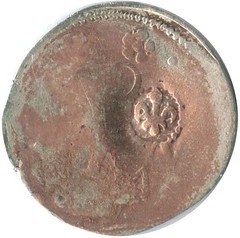
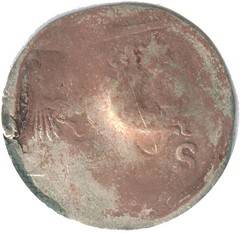
Jan Lingen of Netherlands wrote:
It is a French countermark, period of Louis XIII (1610-1643). Description: Oval countermark with a lily within in a dotted border. The countermark was applied in France to declare current a 1 sol or stuiver of 12 deniers for 15 deniers, against a payment of 2 deniers. Strangely enough such c/m's are found on double stuivers of Holland, Zeeland en Overijssel and some other Dutch coins.
Contemporary records mention complains, that for the sake of profit, also other than the accepted French coins were countermarked. This may explain that they are sometimes found on certain Dutch coins. Nevertheless it is surprising that a Dutch 2 Stuiver, countermarked in France, founds its way to India and from there to Ceylon. The c/m is on a 2 Stuiver of Holland. I got this info verified by the utmost expert of countermarks in the Netherlands and he fully agreed.
Ref.: Beranger, M., L'origine de la surfrappe d'une fleur de lis apposee sur differentes monnaies anterieures a 1640, Revue Numismatique 4.21 (1917-1918), Prochs Verbaux, seance 1918, page LXVIII.
If anyone has or have seen reported a French lily countermarked Dutch coin found in India please E-mail kavanr@yahoo.com .
For more information, see: coins.lakdiva.org/dh1670/161x_hol_2st_lily_cm.html .
The small hoard of 19 silver coins (1600-1669) is described in coins.lakdiva.org/dh1670/
The hoard included
- 9 Zeeland Double Stiuver (1614-1669) coins
- 7 Overijssel Double Stiuver coins
- a Double Stiuver coin from Holland with french countermark
- a Roosschelling of Holland coin
- a Portuguese Double Tanga GA-DS coin
The hoard is claimed to have been with a Lankan family for many generations.
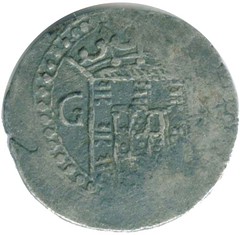
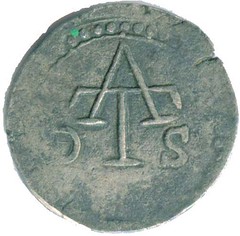
1642 - 1649 - Portuguese Ceilão Silver - Double Tanga - D S
THE BOOK BAZARRE
BALDWIN'S OFFERS MICHAEL HALL COLLECTION OF RENAISSANCE AND LATER MEDALS, PART III
September 2010 brings with it ‘Coinex’, one of the most exciting events of the numismatic calendar and the largest Numismatic coin show in the UK. This year Baldwin’s are proud sponsors of the occasion and, as hosts of the official Coinex auction, a spectacular event awaits.
Baldwin’s two day auction is to be held over the 28th and 29th September and begins with the third part of the Michael Hall Collection of Renaissance and later medals, of which, parts one and two were sold earlier this year through Baldwin’s. New York based collector and art expert Michael Hall spent over fifty years putting together an awe-inspiring collection and this, the final part, offers an array of choice pieces.
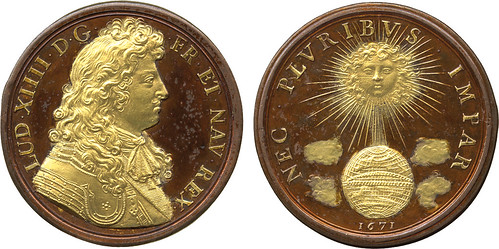
Lot 2090, a 1671 Louis XIV Damascened Medal (estimate £800-1,000) by Jean Warin II is a beautifully crafted piece by arguably the best and most powerful French engraver of coin dies of the 17th Century. Warin (or Varin) came from a family of artists and distinguished himself primarily as a painter and sculptor. He was one of the first engravers to use the power of the medallic form for propaganda purposes in France. Carrying the title of controleur general Warin imposed strict controls over artists that they were allowed no artistic license, but were instead forced to reproduce official designs that commemorated the magnificence of the state. This lot is a prime example of the effectiveness of his creations to this end.

Lot 2614, a Gustav II Adolf Silver medal of 6-Riksdalers by medallist Sebastian Dadler, estimate £1,200 – 1,500, is another one of the stand out pieces of the sale and distinguished by the intricacy of the artwork on both the obverse and reverse of the medal. Dadler was one of the leading medallists of the 17th Century, working widely throughout the courts of Germany and princely houses of Europe, amassing an array of high profile supporters at the time.
The Hall Collection is immediately followed by a diverse selection of commemorative medals and a section of Orders, Decorations and Medals. The extensive Commemorative medal section includes lot 3005, a fantastic 1666 Dutch silver Medal (estimate £1,500 – 2,000) depicting the ‘Four Days’ Naval fight on the obverse and crafted by medallist Jerian Pool.
The medal commemorates the famous action and carries a poem on the reverse by the Dutch writer and playwright, Joost van Vondel, which appears to have been written especially for the medal. Commemorative and historical medals have become a feature of Baldwin’s flagship London auctions and the variety on offer in this sale is testament to the accurate cataloguing and historical referencing that assure Baldwin’s achieve the highest possible prices.
For more information, see: www.baldwin.co.uk
HARVEY STACK ON SUPPORTING YOUNG NUMISMATIST PROGRAMS
 I am working on a book the Kevin Flynn is doing on how to get
younger people into the hobby. As you know, for years the Stack Family supported the Young Numismatists when
Florence Shook got them together at various ANA shows.
We also supported an ANS project of having school children
visit the ANS and get lectures on coins. In addition, back in
the late 40's and 50's we worked with the Chase Money museum
in New York, Vernon Brown curator, to encourage young collectors.
I am working on a book the Kevin Flynn is doing on how to get
younger people into the hobby. As you know, for years the Stack Family supported the Young Numismatists when
Florence Shook got them together at various ANA shows.
We also supported an ANS project of having school children
visit the ANS and get lectures on coins. In addition, back in
the late 40's and 50's we worked with the Chase Money museum
in New York, Vernon Brown curator, to encourage young collectors.
The family's interest in the Young Collectors gave me the inspiration when testifying before Congress and I proposed a face value commemorative quarter series which is the STATEHOOD QUARTER PROGRAM.
The thought for this program was to provide at FACE VALUE a series that could be interesting, each different in design, with the object to get all 50 states. As the ANA has only 30,000 members, the coin papers boast of some 100,000 readers and the magazines less, than I ask where is and who is helping the beginner collector to get started?
The Mint in its "modest way" claims the program that there were as many as 140 million people collecting the Quarters, so I ask WHERE ARE THEY? Even 1% would make our hobby grow, fill the coin collector clubs and shows around the country, and develop a new group to take over for the collectors who no longer collect.
So you see why I am interested in a book for Young Numismatists and of course more senior collectors as well.
I sincerely believe that The E-Sylum, directed at a somewhat more advanced collector, provides the incentive to learn more about Numismatics, Keep up the great work you do!
When I present programs to groups of young people I start off by telling parents and kids that I won't be talking down to them - I don't have to, because numismatics is such an approachable hobby. Sure, things can get very technical and very expensive, but they don't have to. I tell them to reach into their pocket, take out a coin, and LOOK at it. I teach them to see and observe things they've never noticed before. Then I say, "Congratulations - now you're a coin collector."
I never cease to be amazed at how approachable and helpful everyone in this hobby is. Every one of us should take some time to give back to the hobby in some form, and one great way is to reach out to new collectors. -Editor
WHY THE U.S. CENT MAY NEVER DIE
Regarding last week's "anti-penny rant" Joe Boling writes:
Well, Dubner certainly covers all of Dick Johnson's bases about cents and nickels - and is entertaining to watch, as well.
Tom Fort writes:
I read in The E-Sylum of 13 September Dick Johnson's note about the anti-penny rant on the web and his reference to his own anti-penny writings. While these men are right about the state of the penny there is an important factor as to why it will never cease production at current, or higher, levels: The Illinois delegation to the United States Congress.
At present this stands at 2 Senators and 19 members of the House of Representatives. This bipartisan group will fight tooth and nail to keep the penny with Abraham Lincoln on the obverse in circulation. They will almost certainly be helped by the Kentucky delegation (2 Senators, 6 House members) — remember, Lincoln was born there. Likewise they can probably count on the support or veto pen of the President, who was a member of Illinois delegation.
Now some readers may think that I am crazy, but remember that the Virginia delegation to Congress (2 senators, 11 House members) heavily resisted the removal of Monticello from the reverse of the nickel to be temporarily replaced by other designs celebrating the founding of Jamestown that was issued in 2007.
One of the official reasons being that they thought the absence of Jefferson's house would reduce the number of tourists going there. In addition, there was almost certainly the fear that if Monticello was replaced it might set a precedent where other non-Virginian sites might in the future appear on the coin.
If you end production of the penny then you would have to move Lincoln's bust to another piece. Good luck. Our friends in Virginia (fans of Washington and Jefferson) would certainly fight the removal of their men. Likewise, New York (2 Senators, 29 members of the House) would fight the removal of Roosevelt from the dime. Similarly, Massachusetts (2 Senators, 10 House members) want Kennedy on the fifty cent piece.
Since no one uses dollar coins (or the 50 cent piece for that matter), our friends in Illinois would never accept it as a substitute, especially since everyone uses pennies. To make putting Lincoln on the dollar coin acceptable, it would involve ending production of the dollar bill, an act that would outrage the Virginia delegation and the makers of the cloth and ink used in its production. These groups and/or their lobbyists have fought this economically reasonable action with everything they've got.
Political reasons and state egos will usually trump economic sense. This is the nature of the beast: man is both a logical and an emotional creature. After all, why would anyone pay over a million dollars for a coin with a face value of twenty bucks? We may not like the Lincoln penny, but it is here to stay.
To read the earlier E-Sylum article, see: THE BEST ANTI-PENNY RANT EVER? (www.coinbooks.org/esylum_v13n37a15.html)
MORE ON THE WORST NUMISMATIC BOOKS
Apropos bad numismatic books, I am reminded of the 1976 edition of the Scott Comprehensive Catalogue & Encyclopedia of United States Coins, based upon the 1971 edition by Don Taxay but edited by Joseph Rose and Howard Hazelcorn. Some radical changes from the Taxay edition were not
improvements in my opinion, and the illustrations were so bad that the book came from the publisher with several sheets of pictures on gummed sheets with peel-off backs that the buyer was invited to cut out and paste over the original illustration.
That was not the horribly bad book, however. Because the book was intended to serve as a reference that would last several years (unlike the Redbook which was repriced and reissued every year), the publishers decided to offer a small-format companion booklet that could be sold as an updated pricing guide every year, cross-referenced to the numbering system in the main book.
The publishers jobbed this out to somebody on staff who knew nothing about coins. One statement informed you that "All U.S. commemorative coins are so carefully made that they are Proofs." Another paragraph described how all U.S. Coins were made (as best I can remember):
"First one side of the coin is struck, and after it is cleaned and inspected the coin is put back into the press and the other side is struck. After that side is cleaned and inspected, the edge device is added to the coin."
This book inspired Coin World to write its first negative book review ever. Mssrs. Rose and Hazelcorn disavowed any knowledge or connection to the booklet, and I have no reason to doubt them.
Tom adds:
Another bad numismatic book is "The Cleaning and Preservation of Coins and Medals," published in the 1970s. Suffice it to say that the book advocated the use of steel wool to clean coins and medals.
Pete Smith writes:
I don't have a nomination for worst numismatic book ever. Can we come up with another classification? Perhaps "books too worthless to prop up an uneven table leg" or something like that.
To read the earlier E-Sylum article, see: MORE ON THE WORST NUMISMATIC BOOKS (AND WHAT WE LOVE ABOUT ALL OF THEM) (www.coinbooks.org/esylum_v13n37a10.html)
A LIBRARY DESK MADE OF BOOKS
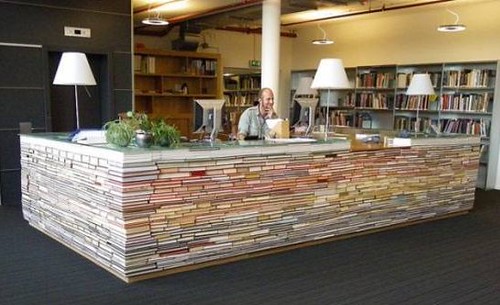
A reader writes, "Books are reused to create this enormous piece of library furniture at TU Delft architecture bibliotheek. Because the books are stacked rather than dismantled, this desk is true to its origins as well as its function."
To read the complete article, see: Enormous library desk made of books (www.boingboing.net/2010/09/15/enormous-library-des.html)
LOST LIBRARIES: THE STRANGE AFTERLIFE OF AUTHORS’ BOOK COLLECTIONS
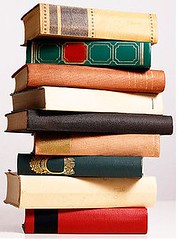 How could the books of one of this generation’s most interesting novelists end up on a bookstore’s dollar clearance carts?
How could the books of one of this generation’s most interesting novelists end up on a bookstore’s dollar clearance carts?
What Markson’s fans had stumbled on was the strange and disorienting world of authors’ personal libraries. Most people might imagine that authors’ libraries matter--that scholars and readers should care what books authors read, what they thought about them, what they scribbled in the margins. But far more libraries get dispersed than saved. In fact, David Markson can now take his place in a long and distinguished line of writers whose personal libraries were quickly, casually broken down.
Herman Melville’s books? One bookstore bought an assortment for $120, then scrapped the theological titles for paper. Stephen Crane’s? His widow died a brothel madam, and her estate (and his books) were auctioned off on the steps of a Florida courthouse. Ernest Hemingway’s? To this day, all 9,000 titles remain trapped in his Cuban villa.
The issues at stake when libraries vanish are bigger than any one author and his books. An author’s library offers unique access to a mind at work, and their treatment provides a look at what exactly the literary world decides to value in an author’s life. John Wronoski, a longtime book dealer in Cambridge, has seen the libraries of many prestigious authors pass through his store without securing a permanent home. ”Most readers would see these names and think, ’My god, shouldn’t they be in a library?’” Wronoski says. ”But most readers have no idea how this system works.”
The literary world is full of treasures and talismans, not all of them especially literary--a lock of Byron’s hair has been sold at auction; Harvard has archived John Updike’s golf score cards.
For private collectors and university libraries, though, the most important targets are manuscripts and letters and research materials--what’s collectively known as an author’s papers--and rare, individually valuable books. In the first category, especially, things can get expensive. The University of Texas’s Harry Ransom Center recently bought Bob Woodward and Carl Bernstein’s papers for $5 million and Norman Mailer’s for $2.5 million. Compared to the papers, the author’s own library takes a back seat. ”An author’s books are important,” says Tom Staley, the Ransom Center’s director, ”but they’re no substitute for the manuscripts and the correspondence. The books are gravy.”
An author’s library, like anyone else’s, reveals something about its owner. Mark Twain loved to present himself as self-taught and under-read, but his carefully annotated books tell a different story. Books can offer hints about an author’s social and personal life. After David Foster Wallace’s death in 2008, the Ransom Center bought his papers and 200 of his books, including two David Markson novels that Wallace not only annotated, but also had Markson sign when they met in New York in 1990. Most of all, though, authors’ libraries serve as a kind of intellectual biography. Melville’s most heavily annotated book was an edition of John Milton’s poems, and it proves he reread ”Paradise Lost” while struggling with ”Moby-Dick.”
And yet these libraries rarely survive intact. The reasons for this can range from money problems to squabbling heirs to poorly executed auctions. Twain’s library makes for an especially cringe-worthy case study because, unlike a lot of now-classic authors, he saw no ebb in his reputation--and, thus, no excuse in the handling of his books. In 1908, Twain donated 500 books to the library he helped establish in Redding, Conn. After Twain’s death in 1910, his daughter, Clara, gave the library another 1,700 books.
The Redding library began circulating Twain’s books, many of which contained his notes, and souvenir hunters began cutting out every page that had Twain’s handwriting. This was bad enough, but in the 1950s the library decided to thin its inventory, unloading the unwanted books on a book dealer who soon realized he now possessed more than 60 titles annotated by Mark Twain.
To read the complete article, see: Lost libraries: The strange afterlife of authors’ book collections (www.boston.com/bostonglobe/ideas/articles/2010/09/19/lost_libraries/)
ON UNIVERSITY DEGREES IN NUMISMATICS
Kerry K. Wetterstrom, Editor/Publisher of The Celator writes:
I've found the E-Sylum discussion on the Roosevelt University's numismatic program very interesting, and thought it might be interesting for someone to contact Jon Kern about his degree in numismatics. If I remember correctly, he has a Bachelor of Science degree in numismatics from the University of Kentucky. It would be interesting to know the details of how he earned his degree, etc.
Degrees in numismatics, usually through archeology programs, are relatively common in Europe, but I'm only aware of Jon Kern and Don Kagan having numismatic degrees from American universities.
Ken Berger writes:
With all the discussion about numismatic education and Roosevelt University, I seemed to recall that Adelphi University started a numismatic program in the 1970s. So, upon doing some quick checking, I found mention of the Institute of Numismatic and Philatelic Studies at Adelphi University in New York.
To read the earlier E-Sylum article, see: www.coinbooks.org/esylum_v13n37a09.html
COIN FOUND IN GERMANY IS SASSANIAN, NOT ARABIC
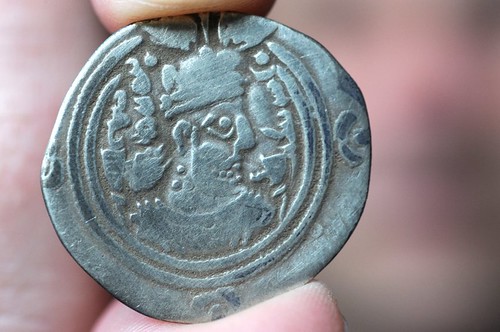
Leon Saryan writes:
Judging from the single picture, the find coins were probably Sassanian and not Arabic.
On our Flickr photo archive page Stu Williams of Ireland offered a similar opinion (in German):
Das is nicht Arabishce aber die Münze Sasanidische. Kushru II (c.591 AD).
Doug Mudd, Curator of the American Numismatic Association's Edward C. Rochette Money Museum writes:
The picture with the Arabic Coins Found in Germany is actually Persian – in fact a Sassanid dirhem of Khusro II (or Xusro). It is of the type that had an Arabic legend added to the outside of the obverse circles – but I do not see one here. The rest of the inscription is in Persian using a Persian script.
As for trading ties going back to the 7th century – the ties had existed before, they just became more tenuous after the fall of the western half of the Roman Empire. The Byzantines had contacts, trade and otherwise, with both regions throughout the Mediaeval period.
To read the earlier E-Sylum article, see: ARABIC COINS OF THE MIDDLE AGES FOUND IN GERMANY (www.coinbooks.org/esylum_v13n37a18.html)
ARTIST USES FOUND CENTS FOR INSPIRATION
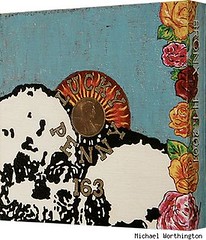
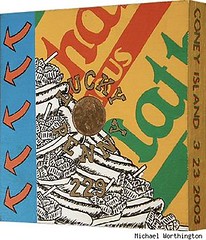
A New York artist attended my auctions when I was selling medals in New York City. He was very selective in the medal he bid on -- it had to have very low relief and a subject which inspired him to create a painting around it. The medal served as the center piece for the total work of art.
Now I learn of another New York artist, Michael Worthington of Brooklyn, who does something similar, but with coins. And only certain coins at that. Only Lincoln cents, and only those he finds on the streets of the city. He picks up each of these, places them in an envelope and writes on the envelope where he found it. The locale is the inspiration for the painting -- not the subject -- which is, of course, only the Brenner Lincoln portrait.
He has, by his count, made 90 paintings. And has hundreds of found pennies in annotated envelopes, ready to paint. He sells his paintings for $200 to $400.
Hey, whatever turns you on. If this story turns you on, click this: www.asylum.com/2010/09/16/lucky-penny-paintings-michael-worthington/ (www.asylum.com/2010/09/16/lucky-penny-paintings-michael-worthington/)
"Find a penny, pick it up and all the day you'll have good luck." Sure, you can bend over, grab a dirty, disease-drenched penny and hope something good comes your way (though more likely you'll catch some virus). Or you can be like Michael Worthington and use that penny to create your own luck.
Worthington is a Brooklyn-based artist who uses the one-cent coin as the centerpiece of his "Lucky Penny Paintings" series.
He finds pennies (or as he puts it, "They usually find me") on the ground, and then creates art based on where he picked up the little Lincoln. Sometimes abstract, sometimes representational, the paintings explore different aspects of these locations.
Worthington, who had been working in the entertainment industry, found himself unemployed by the turn of the century. But he became inspired after navigating the streets of New York.
"I'd walk around, amused by all the change I'd see on city streets," Worthington tells Asylum. "A city so wealthy, money dropped was unimportant."
Worthington saw an artistic opportunity that would change his luck. (See what we did there?) His penny paintings now go for $200 to $400 (or 20,000 to 40,000 pennies).
The 4-by-4-inch square blocks symbolize the artistic interpretation of a particular location, while the penny itself sits prominently in the center of the piece. Around the coin are the words "Lucky Penny," as well as a number, which denotes the order by which Worthington found the penny. The date and city Worthington picked up the copperhead is on the side of the block.
Worthington has turned his currency collection into something of a pop-art travel diary. Think Rick Steves by way of Warhol. For Worthington, each "penny becomes a portal."
ANDY WARHOL’S INDIAN HEAD NICKEL DISPLAYED AT WASHINGTON HOTEL
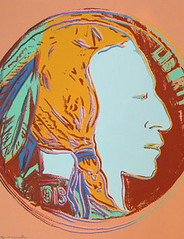 Four Seasons Hotel Washington, DC has unveiled a completely new art collection selected exclusively for the Hotel. Each work of art was painstakingly chosen to blend seamlessly with the interior’s contemporary surroundings while comprising a striking and visually compelling collection. This sophisticated and modern collection respects the unique history of the significant artwork previously displayed in the Hotel.
Four Seasons Hotel Washington, DC has unveiled a completely new art collection selected exclusively for the Hotel. Each work of art was painstakingly chosen to blend seamlessly with the interior’s contemporary surroundings while comprising a striking and visually compelling collection. This sophisticated and modern collection respects the unique history of the significant artwork previously displayed in the Hotel.
“Being familiar with the Hotel’s previous collection, we wanted to create a new compilation that was unique, but still had the feel of someone’s personal art collection and not just something decorative,” says Sarah Hall-Smith, vice president of art consulting and resources for Soho Myraid Gallery. She is directly responsible for selecting all of the paintings. “At the same time, we included some collectibles that both national and international guests would recognise.”
The collection is heavily representative of American artists and is composed of more than 1,650 pieces, 400 of which are premier, blue chip and commissioned pieces for the public spaces and corridors. Among the more prominent public area pieces are works by Roni Stretch, Helen Frankenthaler, Andy Warhol, Robert Mangold, Ron Richmond, Andrea Rosenberg and Andrei Petrov. These were purchased from private collections and exclusive galleries throughout the United States.
Andy Warhol’s 1986 rare screen print trial proof Indian Head Nickel, created a year before his death, greets guests while they are enjoying their complimentary morning coffee or tea in the lobby. Warhol, born in Pittsburgh, was a multi-talented artist whose creativity expanded into filmmaking, music, and writing. He also reinvented the idea of society portraits and used his illustration and advertising designer’s skills to create pop art canvases and sculptures.
To read the complete article, see: New Art Collection Arrives at Four Seasons Hotel in Washington (www.artdaily.org/index.asp?int_sec=2&int_new=40766)
WAYNE'S NUMISMATIC DIARY: SEPTEMBER 19, 2010
After work on Tuesday I made a beeline for the Bertucci's restaurant in Herndon, VA for the September meeting of my Northern Virginia numismatic social group, Nummis Nova. Roger Burdette was already there, along with Bill Eckberg, John Saia and Jon Radel. I was the host for the month and had made the reservation, but they didn't write down my request for a private room. Luckily the room was still available and after a few minutes wait they had it set up for us.
I didn't know it yet, but Dave Schenkman and Gene Brandenburg would be unable to join us as planned. Mike Packard, Joe Levine and Wayne Herndon soon arrived and we all took seats at the table. Last to arrive was Roger's guest, Mitch Sanders. Mitch hails from Rochester, NY and is an E-Sylum reader, Numismatist columnist and former Chairman of the Citizens Coinage Advisory Committee. Mitch sat between me and Roger.
Roger mentioned that he'd located descriptions of WWII pattern cents and he's working on understanding the whole 1941-1944 experimental series including metal, glass and plastic tests. After much work he was finally able to assign one of the plastic pieces to a specific producer and identity its composition and how many were sent to the mint. His research will be published in a book covering American coins and monetary policy from 1929-1946.
The theme I'd picked for exhibits was this:
Old Coin/New Coin: Some Things Never Change. Pick an old coin (or other numismatic item) and pair it up with a modern counterpart. What are the similarities? What are age-old elements of coinage we still see today?
I took the easy way out and brought an example of the 2010 Shield-reverse cent, because of the similarity to the U.S. Two Cent Piece and Shield Nickel. Mike Packard did me one better. He also chose the Shield Cent, but brought along a 1787 New Jersey Cent and 1787 Massachusetts Half Cent with shield designs.
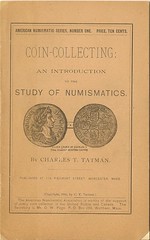
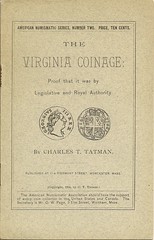
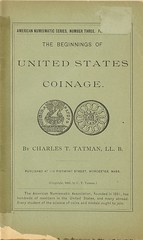
I brought along most of the other exhibit items. I had grabbed a binder of numismatic ephemera from my library. This binder focused on items relating to the American Numismatic Association. Included were Numbers One, Two and Three in the "American Numismatic Series" by Charles Tatman (published 1893, 1894, and 1895, respectively).
- ONE: Coin-Collecting: An Introduction to the Study of Numismatics
- TWO: The Virginia Coinage: Proof That it was by Legislative and Royal Authority
- THREE: The Beginnings of United States Coinage
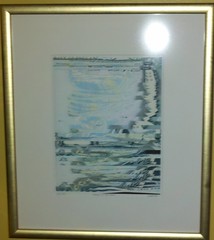 My other display item related to a theme from a previous month when I'd been unable to attend. The theme was "Art in Numismatics", and I brought along a piece by "money artist" J.S.G. Boggs. It's from his Monoprint series. I explained that to create these Boggs hooked up a high-quality scanner and a high-quality color laser printer.
My other display item related to a theme from a previous month when I'd been unable to attend. The theme was "Art in Numismatics", and I brought along a piece by "money artist" J.S.G. Boggs. It's from his Monoprint series. I explained that to create these Boggs hooked up a high-quality scanner and a high-quality color laser printer.
He took a source item (in this case a Bank of England Five Pound banknote) and moved it along the glass as it was being scanned. The resulting print has an interesting wavy pattern. He kept the prints he liked and destroyed the rest. Boggs titled this one "Ripples in the Pond" because the blue color of the note and the wavy image look like, well, ripples in a pond of water. I liked it too, and bought it from an exhibit at a University of Pittsburgh art gallery.
It was November 9, 1994. I remember the night well. Boggs invited everyone attending the opening out to a bar for drinks afterward. We stayed until 1am and then I invited everyone over to my house for a nightcap. The party didn't break up until 3am. I had to get up for work the next day, but somehow I made it. My single days are over now, and my only reason to stay up late is editing The E-Sylum. But I like that monoprint more each year. Click to see a larger image, but the picture doesn't really do it justice - I took it with my cell phone camera and it's a bit out of focus.
Tuesday's dinner broke up around 9:30. It was another thoroughly enjoyable evening of numismatic fellowship. I'm already looking forward to next month.
To read my 1994 mini-diary about the Boggs exhibit, see: J.S.G. Boggs Exhibit Opening (www.limunltd.com/numismatica/mini-diaries/boggs-exhibit.html)
THE BOOK BAZARRE
BONHAMS'S TO SELL MEDAL AWARDED TO CARPATHIA CREW FOR TITANIC RESCUE
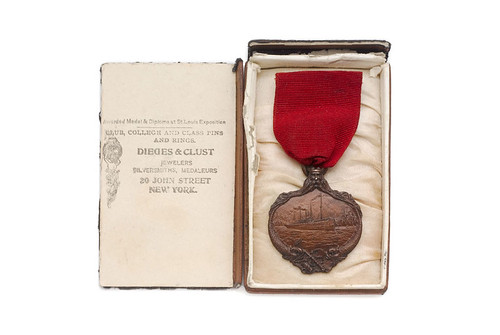
One of the bronze medals presented to the crew of RMS Carpathia, following their heroic rescue of 705 survivors of the stricken Titanic on April 15 1912, is to be sold at Bonhams as part of The Marine Sale on 28 September 2010. Estimated at £2,000 – 4,000, the medal is inscribed: Presented to the Captain Officers and Crew of RMS Carpathia in recognition of gallant and heroic service From the Survivors of the SS Titanic April 15th 1912.
RMS Carpathia was the first ship to reach the survivor’s lifeboats, having received an emergency transmission from the Titanic when it hit an iceberg at 11.40pm on April 14 1912. Diverted from her passage, RMS Carpathia came to the rescue of 705 passengers and took them to safety in New York. On arrival, the Officers and Crew were presented with medals by one of the saved First Class passengers, Margaret (Molly) Brown, to commemorate the rescue: Captain Rostron received a Gold medal and silver cup, the Officers received silver medals, and the Crew received bronze.
To read the complete article, see: Medal Awarded to Carpathia Crew for Rescue of Titanic Survivors to Sell (www.artdaily.org/index.asp?int_sec=2&int_new=40776)
DANIEL CHESTER FRENCH 1893 COLUMBIAN EXPO BULL STATUE RECOVERED

The bulls, each attended by a different goddess — one the Roman goddess of grain, the other a Native American goddess of corn — arrived at Garfield Park in the early 20th century, a time when Chicago was bursting with newcomers and proud to put big, new art in its grand, new parks.
The sculptures had been created by Daniel Chester French and Edward Clark Potter as plaster models for two even larger bulls that ornamented the livestock exhibit at the 1893 World's Columbian Exposition.
French had already designed the Minute Man statue in Concord, Mass. He would go on to create the Abraham Lincoln memorial statue in Washington, D.C., and to design the Pulitzer Prize gold medal. Potter, his student, modeled the lions in front of the New York Public Library.
In other words, the artists were a big deal. So were the bulls.
The "World's Fair Bulls," as they were called, greeted Garfield Park strollers at the entry to the formal garden. They were so popular that shortly after their 1909 installation, they were cast in bronze.
But by the 1980s, Chicago's West Side was suffering, and in Garfield Park, drugs and weeds flourished more reliably than art and roses.
It took a passing tour guide to report that the bull and the goddess of corn were gone.
Meanwhile, the matching bull remained, its base cockeyed, as if someone had tried to nab it too. Its tail had been hacked off, along with the goddess of grain's arm.
A $1,000 reward was offered for the return of the missing bull. It never returned.
Twenty-four years passed.
One day this February, Julia Bachrach, the Chicago Park District historian, opened an e-mail. It was from the head of a New York auction house, saying she had a curious item: a big bronze bull with a goddess attached.
The bull had shown up on an estate in Virginia. The owner had died. An appraiser had done some Internet research.
The Mystery of the Missing Bull may never be fully solved. But at least the bull is home. It will go back on display as soon as another mystery is solved: where to find the money to restore it.
"It's comparable to the lions in front of the Art Institute," Dajnowski said. "Imagine finding one of the lions. We found a treasure."
To read the complete article, see:
Solved (almost): The mystery of the missing one-ton bull statue
(www.latimes.com/features/odd-news/ct-met
-schmich-0912-20100912,0,577154,full.column)
MAST COIN FOUND IN SHIP EXCAVATED AT WORLD TRADE CENTER SITE
As Nichole Doub -- Head Conservator at the Maryland Archaeological Conservation Laboratory -- was helping extract the remains of an 18th century ship from the mud of the World Trade Center construction site, she was asked a familiar question:
While we’re out on the site, we have all these construction workers coming up and one of the most common questions asked any archaeologist on a site is: Have you found the gold yet? It’s kind of the question that everyone asks. And normally you go “No, no.”
But in this case there’s a chance we could find gold. And that’s if we found one of the lucky coins.
Lucky coin? Ever since the 2nd century B.C. -- not long after Romans began minting coins -- shipbuilders have been slipping a coin into the structure of their ships. It’s a tradition that continues today. In fact, the USS New York - made partially from steel recovered from the World Trade Center towers - did it as well.
For the ancient Romans it was likely a continuation of religious customs. Now it's just a tradition and done for good luck.
So we didn’t find it during the five days we were actually excavating it. However, one of my curators did find it between the stern knee and the stern post while we were cleaning the timbers.
Here's what they found:
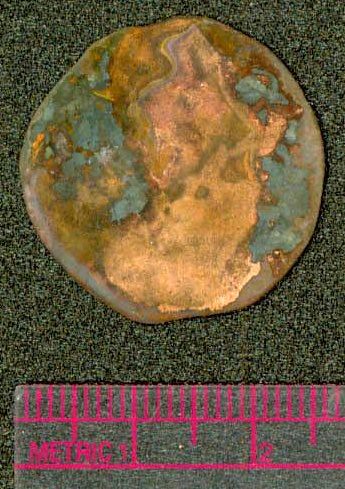
I wasn't so sure I wanted to publish this, since the coin is so butt-ugly and virtually unidentifiable. Tim adds:
Maybe if PCGS scanned it with their new system traces of lines would become visible, but it looks too far gone for even that technology. Considering all the skills of E-Sylum readers for coins of the era (excluding me), someone might figure it out, the diameter being a starting clue. It will also be helpful once some general dates are established from the wood analysis.
To read the complete article, see: WTC Ship Gives Up Lucky Coin (news.discovery.com/archaeology/wtc-ship-gives-up-lucky-coin.html)
FANCIERS TO HONOR DICKIN MEDAL WINNING PADDY THE PIGEON
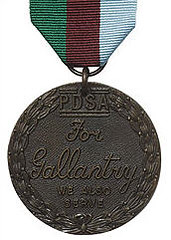 A pigeon from Northern Ireland which flew vital information from France after the D-Day landings will be commemorated with a re-enactment of his dangerous and historic flight later this month.
A pigeon from Northern Ireland which flew vital information from France after the D-Day landings will be commemorated with a re-enactment of his dangerous and historic flight later this month.
Dozens of pigeons will take to the sky to fly the same route as the famous pigeon who was the only Irish animal decorated for bravery during the Second World War.
Fanciers from the UK and Northern Ireland will be asked to release their birds, on a date still to be arranged, in France for a pigeon race that will in effect be a repeat of ‘Paddy's’ trip back to his loft in Hampshire in the record time of 4 hours 50 minutes, 66 years ago.
The move is delighting people in Carnlough, where Paddy was born and bred and is still revered to this day, and where a plaque in his memory is on permanent display on a harbour wall.
Research is ongoing in an attempt to pinpoint the exact spot on the Normandy beaches where Paddy commenced his mission.
It is thought the pigeon flew from a place called Carentan in Normandy, but the exact route he took home will never be known.
In the meantime, there will be a Paddy Memorial Day in Larne Arts Centre on Friday September 24, organised by Jenny Caldwell, heritage officer of Larne Borough Council and the town historical society, along with Ballymena HPS.
It will be attended by ex-Irish Army officer Kevin Spring, a fancier who now owns Paddy's Dickin Medal for Bravery — valued at around £10,000 — which he will be showing off to guests.
Paddy, whose Dickin Medal is the animal world's equivalent of the Victoria Cross, came from the Moyleen loft of the late Carnlough fancier Andrew Hughes, who handed him over to the National Pigeon Service in which he was trained for his military career.
To read the complete article, see:
(www.belfasttelegraph.co.uk/news/local-national/
northern-ireland/flying-aces-relive-dday-exploits-of-paddy-the-pigeon-14948404.html)
BANK ROBBER FILLS OUT PAPERWORK FOR A LOAN
A man was arrested Wednesday afternoon after he walked into a Watsonville bank, said he had a bomb in his backpack and demanded $2,000 so he could pay his friend's rent, police reported.
But when Mark Smith, 59, allegedly tried to rob the bank, the bank manager suggested that what he actually needed to do was take out a loan, and she had him sit down while she said she was going to retrieve the loan paperwork. Instead, she called 911, according to Assistant District Attorney Dave Genochio.
"Quick-thinking staff kept the man calm and distracted him with some paperwork until we arrived," Lt. Darren Thompson said.
To read the complete article, see: Man claiming to have a bomb in Watsonville bank gets talked into filling out loan paperwork, then arrested (www.santacruzsentinel.com/localnews/ci_16033532)
FEATURED WEB PAGE: ABNER KREISBERG'S 50% OFF SALE
This week's Featured Web Page is a great story by Harvey Stack about a practical joke played on another coin dealer at the 1960 American Numismatic Association convention. 'Harvey Stack Remembers' is a series that he wrote during his later days at Stack's to help people see how numismatics was conducted through the years.
On the second day, Earl Parker, the popular San Francisco dealer and friend, who was well known for having little or no patience, virtually threw his keys to Abner Kreisberg. “I ain’t doing anything here. I’m hungry and I am going out to eat. I hope you can give my table some life.” Apparently, he had no sales at all to this point.
Abner accepted the keys, and Earl left the floor. Abner was a great guy and also a prankster. He gathered the rest of us together and said, “Let’s see if we can make a sale for Earl.” After about 45 minutes Earl didn’t return. Abner got an idea. He opened Earl’s cases and picked up about 10 coins valued from $500 to $5,000 each, and left the empty places in the case. He put the group in an envelope and hid it in his case.
To make the incident climactic he asked me to make two signs, one for each case, stating “50% OFF ANY COIN IN THIS CASE.” When we saw Earl coming back we quickly placed one sign in each case, and then sat back looking at the ceiling.
As Earl approached his case he quickly noticed the empty spaces. He cried out “Abner, you’re a super salesman. How did you do it? What did you sell?”
Before Abner could respond, because he began to laugh as hard as we all did, Earl saw the two signs.
Earl screamed out –“Abner are you crazy? Did you lose your mind? I paid within 15-20% below what I priced the coins for. I’m going to lose a fortune.”
By this time all of us were laughing so hard, enjoying watching Earl’s face turn bright red, that no one could answer him.
Abner played along with the prank for at least another 5 minutes and finally took the coins out of his case and gave them to Earl. Earl fell into a chair and after calming down, turned to Abner and said, “Abner, I know it had to be you, this is the best prank ever! My only regret is I didn’t do it to you!”
news.stacks.com/content/the-ana-convention-1960-
dealers-sometimes-get-playful/
